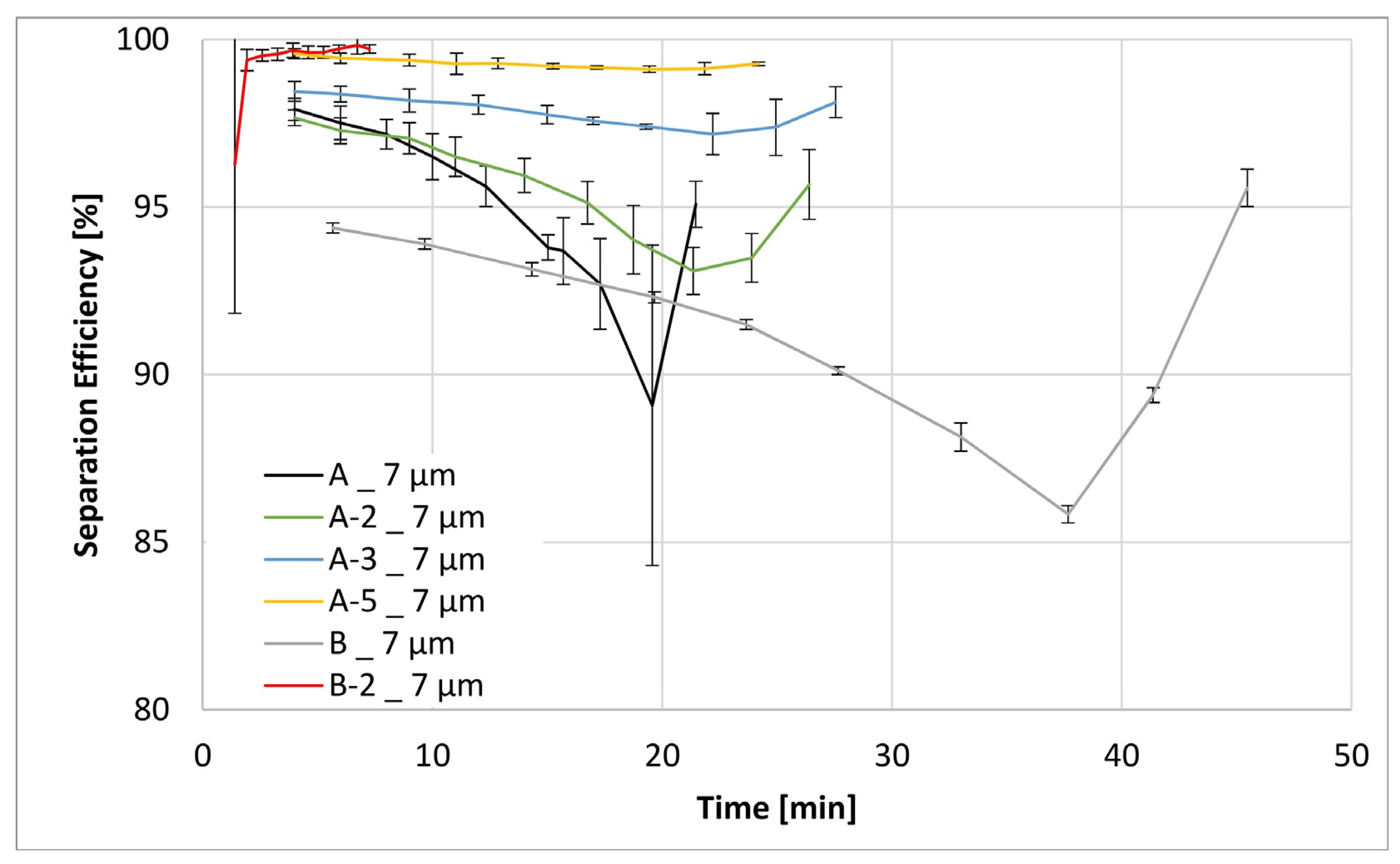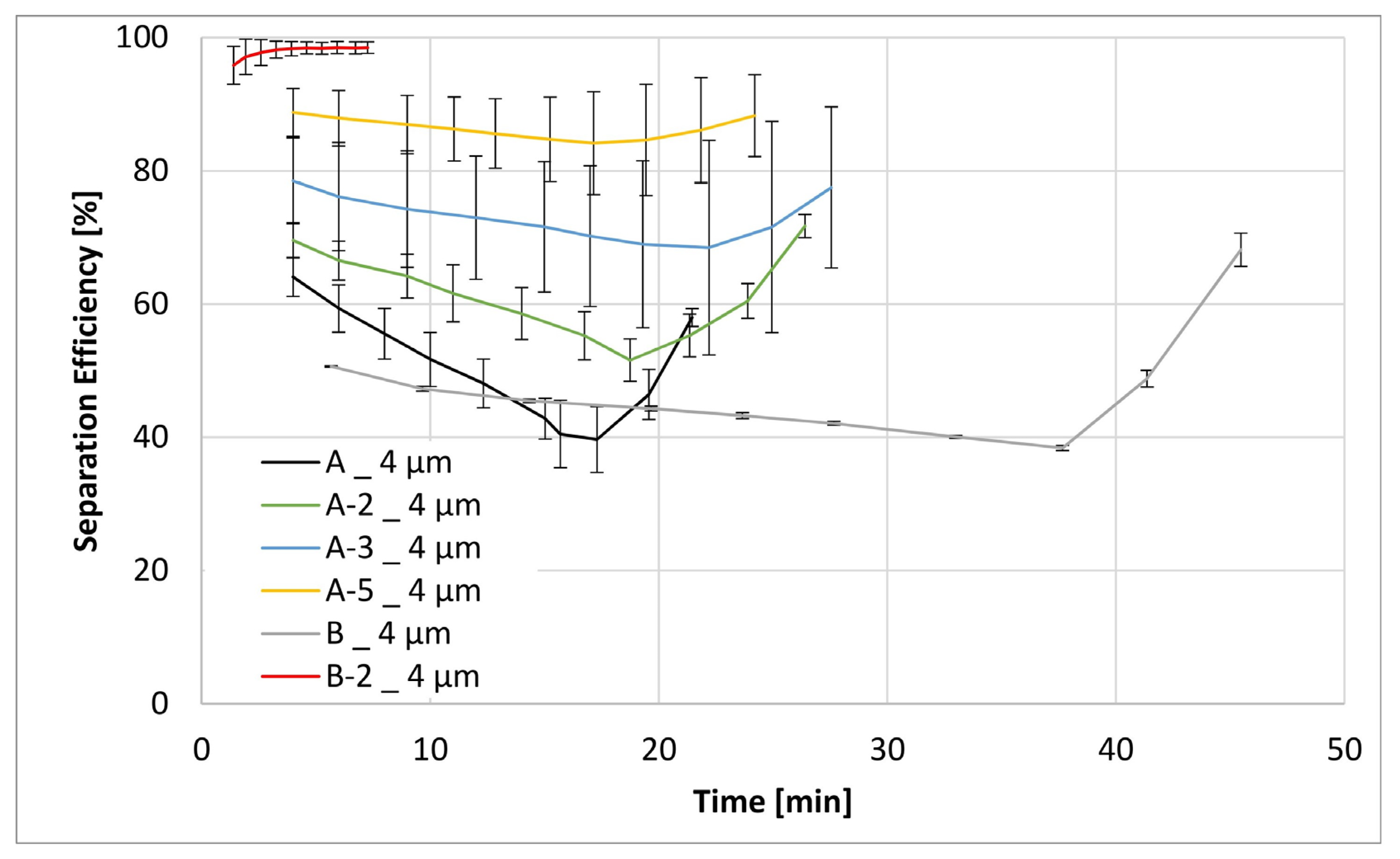Enhancement of Filtration Performance Characteristics of Glass Fiber-Based Filter Media, Part 1: Mechanical Modification with Electrospun Nanofibers
Abstract
:1. Introduction
2. Materials and Methods
2.1. Textile Material Characterization Procedures
2.2. Evaluation of the Filtration Performance Characteristics
2.3. The Impact of Physical Filter Media Modifications
3. Experimental Results
- Nb = Number of particles before the filter medium;
- Na = Number of particles after the filter medium.
4. Discussion
5. Conclusions
Author Contributions
Funding
Institutional Review Board Statement
Informed Consent Statement
Data Availability Statement
Acknowledgments
Conflicts of Interest
References
- Eyvaz, M.; Arslan, S.; Gürbulak, E.; Yüksel, E. Textile materials in liquid filtration practices: Current status and perspectives in water and wastewater treatment. Text. Adv. Appl. 2017, 1, 293–320. [Google Scholar] [CrossRef]
- Sutherland, K.S.; Chase, G. Filters and Filtration Handbook; Elsevier: Amsterdam, The Netherlands, 2011; ISBN -978-1-8561-7464-0. [Google Scholar]
- Ji, X.; Huang, J.; Teng, L.; Li, S.; Li, X.; Cai, W.; Chen, Z.; Lai, Y. Advances in particulate matter filtration: Materials, performance, and application. Green Energy Environ. 2023, 8, 673–697. [Google Scholar] [CrossRef]
- Wente, V.A.; Lucas, R.T. Formation of filter materials from glass fibers. Ind. Eng. Chem. 1956, 48, 219–222. [Google Scholar] [CrossRef]
- Qin, X.; Subianto, S. Electrospun Nanofibers for Filtration Applications; Woodhead Publishing: Sawston, UK, 2017; pp. 449–466. [Google Scholar] [CrossRef]
- Qin, X.; Wang, S. Filtration properties of electrospinning nanofibers. J. Appl. Polym. Sci. 2006, 102, 1285–1290. [Google Scholar] [CrossRef]
- Graham, K.; Ouyang, M.; Raether, T.; Grafe, T.; McDonald, B.; Knauf, P. Polymeric nanofibers in air filtration applications. In Proceedings of the 5th Annual Technical Conference & Expo of the American Filtration & Separations Society, Galveston, TX, USA, 9–12 April 2002. [Google Scholar]
- Marzocchi, A.; Lachut, F.; Willis, W.H. Glass Fibers and Their Use as Filter Media. J. Air Pollut. Control. Assoc. 1962, 12, 38–42. [Google Scholar] [CrossRef]
- Brown, P.; Cox, C.L. Fibrous Filter Media; Woodhead Publishing: Sawston, UK, 2017; ISBN 0081005733. [Google Scholar]
- Cioara, L.; Cioara, I. Functional Design of the Woven Filters. In Advances in Modern Woven Fabrics Technology; IntechOpen: London, UK. [CrossRef]
- Purchas, D.B.; Sutherland, K. Handbook of Filter Media; Elsevier: Amsterdam, The Netherlands, 2002; ISBN 1-85617-375-5. [Google Scholar]
- Seydibeyoglu, M.O.; Mohanty, A.K.; Misra, M. Fiber Technology for Fiber-Reinforced Composites; Woodhead Publishing: Sawston, UK, 2017; pp. 153–167. [Google Scholar]
- Bauer, J.F.; Manville, J. Properties of glass fiber for filtration: Influence of forming process. Int. Nonwovens J. 2004, 4, 2–7. [Google Scholar] [CrossRef]
- Sakthivel, S.; Ezhil, A.J.; Ramachandran, T. Development of needle-punched nonwoven fabrics from reclaimed fibers for air filtration applications. J. Eng. Fibers Fabr. 2014, 9, 149–154. [Google Scholar] [CrossRef]
- Visvanathan, C.; Aim, R.B. Water, Wastewater, and Sludge Filtration; CRC Press: Boca Raton, FL, USA, 2020; ISBN 0-8493-6983-5. [Google Scholar]
- Zou, C.; Shi, Y.; Qian, X. Characterization of glass fiber felt and its performance as an air filtration media. J. Ind. Text. 2022, 51, 1186S–1206S. [Google Scholar] [CrossRef]
- Keirouz, A.; Wang, Z.; Reddy, V.S.; Nagy, Z.K.; Vass, P.; Buzgo, M.; Ramakrishna, S.; Radacsi, N. The history of electrospinning: Past, present, and future developments. Adv. Mater. Technol. 2023, 8, 2201723. [Google Scholar] [CrossRef]
- Cramariuc, B.; Cramariuc, R.; Scarlet, R.; Manea, L.R.; Lupu, I.G.; Cramariuc, O. Fiber diameter in electrospinning process. J. Electrost. 2013, 71, 189–198. [Google Scholar] [CrossRef]
- Teo, W.E.; Ramakrishna, S. A review on electrospinning design and nanofibre assemblies. Nanotechnology 2006, 17, R89. [Google Scholar] [CrossRef] [PubMed]
- Doshi, J.; Reneker, D.H. Electrospinning process and applications of electrospun fibers. J. Electrost. 1995, 35, 151–160. [Google Scholar] [CrossRef]
- Meng, Y.; Liu, G.; Liu, A.; Guo, Z.; Sun, W.; Shan, F. Photochemical Activation of Electrospun In2O3 Nanofibers for High-Performance Electronic Devices. J. ACS Appl Mater Interfaces. 2017, 9, 10805–10812. [Google Scholar] [CrossRef] [PubMed]
- Yang, G.; Li, X.; He, Y.; Ma, J.; Ni, G.; Zhou, S. From nano to micro to macro: Electrospun hierarchically structured polymeric fibers for biomedical applications. Prog. Polym. Sci. 2018, 81, 80–113. [Google Scholar] [CrossRef]
- Manea, L.R.; Scarlet, R.; Leon, A.L.; Sandu, I. Control of Nanofibers production process through electrospinning. Rev. Chim. 2015, 66, 640–644. [Google Scholar]
- Al-Abduljabbar, A.; Farooq, I. Electrospun polymer nanofibers: Processing, properties, and applications. Polymers 2022, 15, 65. [Google Scholar] [CrossRef] [PubMed]
- Guo, Y.; He, W.; Liu, J. Electrospinning polyethylene terephthalate/SiO2 nanofiber composite needle felt for enhanced filtration performance. J. Appl. Polym. Sci. 2020, 137, 48282. [Google Scholar] [CrossRef]
- Wertz, J.; Schneiders, I. Filtration media: Advantages of nanofibre coating technology. Filtr. Sep. 2009, 46, 18–20. [Google Scholar] [CrossRef]
- Li, L.; Shang, L.; Li, Y.; Yang, C. Three-layer composite filter media containing electrospun polyimide nanofibers for the removal of fine particles. Fibers Polym. 2017, 18, 749–757. [Google Scholar] [CrossRef]
- Cigdem, A. NANOFIBERS IN FILTRATION. 2019. Available online: https://www.researchgate.net/publication/335025947_NANOFIBERS_IN_FILTRATION (accessed on 29 April 2024).
- Li, D.; Frey, M.W.; Joo, Y.L. Characterization of nanofibrous membranes with capillary flow porometry. J. Membr. Sci. 2006, 286, 104–114. [Google Scholar] [CrossRef]
- Bartholdi, D.; Erlenmaier, I.; Seitz, A.; Maurer, C. Filter media performance and its influence on filtration results-experience, expectations and possibilities in vacuum and pressure filtration. Filtech Conf. 2015, 13, 17. [Google Scholar]
- DuPont de Nemours, I. Test Methods Based on Methodologies from Astm, Iso and Others. 2018. Available online: https://www.dupont.co.za/news/measuring-properties-of-tyvek.html (accessed on 29 April 2024).
- Jena, A.; Gupta, K. Characterization of pore structure of filtration media. Fluid/Part. Sep. J. 2002, 14, 227–241. [Google Scholar]
- Jena, A.; Gupta, K. Liquid extrusion techniques for pore structure evaluation of nonwovens. Int. Nonwovens J. 2003, 3, 45–53. [Google Scholar] [CrossRef]
- Lifshutz, N. On the ‘mean flow’ pore size distribution of microfiber and nanofiber webs. Int. Nonwovens J. 2005, 1, 18–24. [Google Scholar] [CrossRef]
- DIN EN ISO 5084:1996; DIN, ENISO. Textiles–Determination of thickness of textiles and textile products. ISO: Geneva, Switzerland, 1996.
- DIN EN 12127:1997; Textilien—Textile Flächengebilde—Bestimmung der flächenbezogenen Masse unter Verwendung kleiner Proben; Deutsche Fassung. Available online: https://www.dinmedia.de/de/norm/din-en-12127/3569979 (accessed on 26 April 2024).
- DIN EN ISO 9237:1995; DIN, ENISO. Textilien–Bestimmung der Luftdurchlässigkeit von textilen Flächengebilden. ISO: Geneva, Switzerland, 1995.
- ASTM F316-03:2011; Standard Test Methods for Pore Size Characteristics of Membrane Filters by Bubble Point and Mean Flow Pore Test. Available online: https://www.astm.org/f0316-03r19.html (accessed on 26 April 2024).
- ISO 16889:2022; Hydraulic Fluid Power. Available online: https://www.iso.org/standard/77245.html (accessed on 26 April 2024).
- ISO 3968:2017; Hydraulik-Filter-Bestimmung des Druckabfalles in Abhängigkeit von der Durchflusscharakteristik. Available online: https://www.dinmedia.de/de/norm/iso-3968/278003936 (accessed on 26 April 2024).
- Eleftherakis, J.G.; Khalil, A. Multipass Beta Filtration Testing for the 21st Century. Int. Nonwovens J. 2000, 3, 36–40. [Google Scholar] [CrossRef]
- Theron, S.; Zussman, E.; Yarin, A. Experimental investigation of the governing parameters in the electrospinning of polymer solutions. Polymer 2004, 45, 2017–2030. [Google Scholar] [CrossRef]
- Forouharshad, M.; Saligheh, O.; Arasteh, R.; Farsani, R.E. Manufacture and characterization of poly (butylene terephthalate) nanofibers by electrospinning. J. Macromol. Sci. Part B 2010, 49, 833–842. [Google Scholar] [CrossRef]
- Strain, I.N.; Wu, Q.; Pourrahimi, A.M.; Hedenqvist, M.S.; Olsson, R.T.; Andersson, R.L. Electrospinning of recycled PET to generate tough mesomorphic fibre membranes for smoke filtration. J. Mater. Chem. A 2015, 3, 1632–1640. [Google Scholar] [CrossRef]
- Luzio, A.; Canesi, E.V.; Bertarelli, C.; Caironi, M. Electrospun polymer fibers for electronic applications. Materials 2014, 7, 906–947. [Google Scholar] [CrossRef]
- DIN EN ISO 5269-2; Faserstoffe—Laborblattbildung für physikalische Prüfungen—Teil 2: Rapid-Köthen-Verfahren. Available online: https://www.dinmedia.de/de/norm/din-en-iso-5269-2/76461319 (accessed on 29 April 2024).














| Physical Properties | Method | Apparatus |
|---|---|---|
| Thickness | DIN EN ISO 5084:1996 [35] | Thickness gauge without pressure—Mitutoyo Deutschland GmbH, Neuss, Germany |
| Basis Weight | DIN EN 12127:1997 [36] | MSA225P-000-DA—Sartorius AG, Göttingen, Germany |
| Air Permeability | DIN EN ISO 9237:1995 [37] | FX3300—Textest AG, Schwerzenbach, Switzerland |
| Pore Size Distribution | ASTM F316-03:2011 [38] | Capillary Flow Porometer AX 1100—Porous Materials INC., Ithaca, NY, USA |
| Samples | Thickness [mm] | Basis Weight [g m−2] | Air Permeability [L m−2 s−1] | Min Pore [µm] | Max Pore [µm] | MFP [µm] |
|---|---|---|---|---|---|---|
| A | 0.5 ± 0.0 | 75.5 ± 1.8 | 230 ± 7 | 4.5 ± 0.0 | 35.0 ± 0.1 | 14.9 ± 0.3 |
| A-2 | 0.5 ± 0.0 | 76.2 ± 3.2 | 230 ± 11 | 4.6 ± 0.1 | 42.0 ± 1.1 | 14.8 ± 0.0 |
| A-3 | 0.5 ± 0.0 | 76.7 ± 0.7 | 185 ± 5 | 3.6 ± 0.1 | 40.5 ± 3.2 | 12.7 ± 0.2 |
| A-5 | 0.5 ± 0.1 | 72.4 ± 8.8 | 152 ± 1 | 2.9 ± 0.1 | 36.7 ± 7.5 | 10.4 ± 1.4 |
| Samples | Thickness [mm] | Basis Weight [g m−2] | Air Permeability [L m−2 s−1] | Min Pore [µm] | Max Pore [µm] | MFP [µm] |
|---|---|---|---|---|---|---|
| B | 0.5 ± 0.0 | 71.7 ± 1.7 | 230 ± 22 | 5.1 ± 0.2 | 30.3 ± 0.1 | 12.8 ± 0.5 |
| B-2 | 0.5 ± 0.0 | 70.5 ± 1.1 | 30 ± 3 | 0.6 ± 0.0 | 22.3 ± 4.8 | 12.3 ± 2.4 |
| B-3 | 0.5 ± 0.0 | 69.6 ± 2.6 | 27 ± 9 | 0.6 ± 0.0 | 11.8 ± 0.7 | 6.6 ± 1.0 |
| B-5 | 0.6 ± 0.0 | 67.8 ± 2.4 | 20 ± 9 | 0.6 ± 0.0 | 8.4 ± 2.8 | 6.3 ± 1.4 |
| Sample | Separation Efficiency [%] for Particle Size [µm] | DHC [g] | DPQ [bar] | ||||||
|---|---|---|---|---|---|---|---|---|---|
| >4 | >5 | >7 | >12 | 3 bar | 5 bar | 1 L min−1 | 2 L min−1 | 8 L min−1 | |
| A | 50.6 | 71.4 | 94.9 | 99.8 | 1.28 | 0.03 | 0.26 | ||
| A-2 | 61.5 | 74.7 | 95.6 | 99.8 | 1.48 | 0.03 | 0.24 | ||
| A-3 | 73.0 | 85.5 | 97.9 | 99.8 | 1.52 | 0.02 | 0.30 | ||
| A-5 | 86.3 | 94.5 | 99.3 | 99.8 | 1.34 | 0.04 | 0.37 | ||
| B | 46.8 | 64.4 | 91.4 | 99.6 | 2.40 | 0.02 | 0.18 | ||
| B-2 | 97.9 | 98.9 | 99.3 | 99.2 | 0.25 | 0.16 | 4.56 | ||
| B-3 | 2 | 3.36 | |||||||
| B-5 | 5 | ||||||||
Disclaimer/Publisher’s Note: The statements, opinions and data contained in all publications are solely those of the individual author(s) and contributor(s) and not of MDPI and/or the editor(s). MDPI and/or the editor(s) disclaim responsibility for any injury to people or property resulting from any ideas, methods, instructions or products referred to in the content. |
© 2024 by the authors. Licensee MDPI, Basel, Switzerland. This article is an open access article distributed under the terms and conditions of the Creative Commons Attribution (CC BY) license (https://creativecommons.org/licenses/by/4.0/).
Share and Cite
Weiter, L.; Leyer, S.; Duchowski, J.K. Enhancement of Filtration Performance Characteristics of Glass Fiber-Based Filter Media, Part 1: Mechanical Modification with Electrospun Nanofibers. Materials 2024, 17, 2209. https://doi.org/10.3390/ma17102209
Weiter L, Leyer S, Duchowski JK. Enhancement of Filtration Performance Characteristics of Glass Fiber-Based Filter Media, Part 1: Mechanical Modification with Electrospun Nanofibers. Materials. 2024; 17(10):2209. https://doi.org/10.3390/ma17102209
Chicago/Turabian StyleWeiter, Laura, Stephan Leyer, and John K. Duchowski. 2024. "Enhancement of Filtration Performance Characteristics of Glass Fiber-Based Filter Media, Part 1: Mechanical Modification with Electrospun Nanofibers" Materials 17, no. 10: 2209. https://doi.org/10.3390/ma17102209






